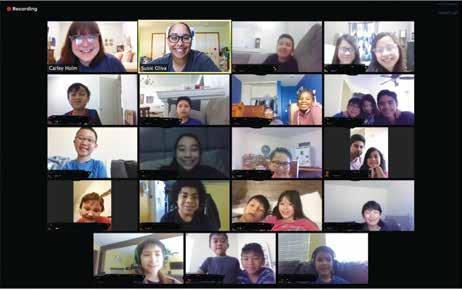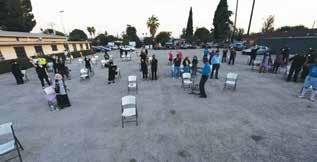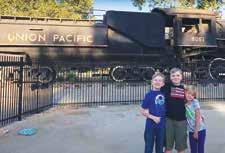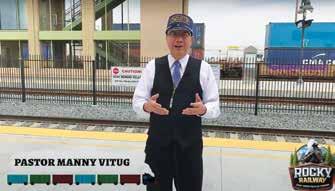
10 minute read
Southeastern California Conference
SECC Educators and Students Begin School Year with Resilience and Faith
By Tricia Murdoch Zmaj
The first day of school looked very different this year. While educators in Southeastern California Conference (SECC) schools were in their classrooms, their students started their new grades interacting with their teachers and peers through computer screens.
Susie Oliva, teaching principal of the K-8 Victor Valley school, is a veteran teacher of 15 years. “In some ways it feels like the first year of teaching again,” she said. “The new technology has given me an opportunity to reach students in helpful ways.”
Recently, Oliva took part in training offered by the Office of Education to teach principals to use Swivl. The Office of Education also offered teachers three days of training on digital instructional methods and student engagement when they reported to work for the new school year.
“The Swivl system allows the teacher to move around the classroom as they normally would, and the camera will follow them where they go,” said Amy Cornwall, SECC director of instructional coaching. “Teachers can use hands-on instruction while allowing the students at home to see and interact with the teacher and their classmates.”
SECC teachers are mindful that remote education is not merely technically challenging. “The two greatest challenges teachers will experience this year are helping parents feel supported and creating meaningful connections with students,” said Ketita Boren, first grade teacher at Mesa Grande
Victor Valley teachers and students take part in a Zoom Bible study on the final day of last school year.
Academy. Boren is providing her class parents with a detailed guide to an organized learning environment at home. She also recently sent out student questionnaires so that she can prepare teaching strategies and activities designed for her students.
Even through remote education, SECC schools offer a unique experience. “Adventist education continues to help students reach their highest potential while recognizing that true education aligns the students’ spiritual, mental, and physical development with God’s ideal for mankind,” said Boren.
Oliva regularly hears from parents who appreciate the family feeling of their Adventist school despite the additional workload that current circumstances require. When the students began learning remotely last spring, Oliva and teacher Carley Holm continued their daily worships, in which students and teachers met for prayer and Bible study via Zoom. Oliva has a screen capture from the final Bible study of last school year. In the picture, students sit at various kitchen tables, by living room desks, and in front of bedroom walls. Though their school experiences look very different, each student wears a beaming smile.
Prayer Vigil Unites Church Communities
By Suzanne Ocsai
Arriving early at the San Bernardino Community church for the Prayer Vigil for Unity and Racial Injustice on Saturday, June 27, Bryant Taylor, worship and media pastor at Azure Hills church, noted that everyone was especially quiet. Even as more of the nearly 100 attendees arrived, there was still a noticeable silence. As he looked out on the crowd that was forming, he saw a seriousness and sadness in their eyes.
On June 12, following the murder of George Floyd while in the custody of Minneapolis police officers, the North American Division published a press release asking all members to observe a special day of prayer on the last Sabbath in June.
Tara VinCross, senior pastor of the Azure Hills church, reached out to Jerrold Thompson, pastor at the San Bernardino Community church, with the idea of holding a joint prayer vigil.
“It’s our responsibility as a church to step up and to respond directly,” said Jessie Lopez, young adult pastor at Azure Hills church, who helped plan the event. “It is a reflection of who God is to stand up and speak against oppression, to speak against any form of injustice.”
The two churches planned to equally share each aspect of the programming, alternating between members of San Bernardino Community and Azure Hills churches for prayers, spoken word
(Left) Bryant Taylor, worship and media pastor at Azure Hills church, challenges the audience to act justly to all people, not just the people they know. (Below) Attendees lift their phones during the song “This Little Light of Mine” in solidarity to shine the light on injustice.
performances, special music, calls to action, and prayers of action.
After a welcome, VinCross led attendees in a moment of silence that lasted exactly eight minutes and 46 seconds—the same amount of time Floyd was pinned beneath the officer’s knee before he died. This was followed by prayers of repentance that led into the rest of the programing.
As the vigil came to a close, Thompson and Taylor led calls to action.
“This is not a political fight,” Thompson said during the vigil. “When you politicize it, then you demonize it. Our call to action is for us to be more like Jesus. Let’s not politicize this but make sure this is biblical.”
Taylor challenged the non-Black attendees to not simply stand up for

the persons of color they know and respect but to stand up for all persons of color.
“Every white person has someone that they know that’s Black that they would step in and do something for,” Taylor said. “But I didn’t want them to do it for that reason. I wanted them to do it because it was wrong.”
Following the vigil, both churches committed to continuing their partnership, and they hope other churches will seek similar relationships with sister churches.
“I just want people to be inspired to pick up the phone and call their Black pastor down the street, or the Black pastor call the white pastor down the street or another ethnicity, and do something for their community together,” said Thompson.

While camp had to be canceled, that didn’t mean that some camp favorites couldn’t still be offered virtually. Carmen Ibanez, Pine Springs Ranch executive director, received special permission to host the PSR leadership team at the camp for one weekend to help her record and prepare videos featuring camp games, crafts, songs, activities, and snacks that campers could watch at home. All the videos were then posted online at psrathome.org.
For VBS, SECC leaders offered churches two virtual options. One was a one-week, online VBS program called Heroes, created by the North American Division, and the other was a semi-customizable program from the conference called Rocky Railway: Jesus’ Power Pulls Us Through. Because so many summer activities had to be canceled this year, pastors decided that instead of offering the customizable VBS for just one week, they would spread the five-day programming over five weeks. While this created much more work for the pastors, they wanted to provide more fun opportunities to families with limited options.
“It’s nice for one week,” said Manny Vitug, associate youth director for family and children’s ministry, “but
The leadership team records videos of favorite camp songs, crafts, activities, and more. All of these activities are posted on psrathome.org for virtual camp
SECC Camp, VBS Offered Virtually
By Suzanne Ocsai
Pine Springs Ranch summer camp and Vacation Bible School (VBS) are summer staples for kids, teens, and the young adults who help staff both. A summer without one of these wouldn’t quite be summer. So, when COVID-19 claimed summer plans, conference staff and local church leaders decided to reimagine what both programs could look like in the midst of social distancing restrictions during quarantine.
attendees.
the kids are going to be home for the entire summer with nothing to do—some of them even go from one church to the next, visiting different VBS programs.”
The VBS began on June 29 and ran until July 31. Each day of the original week-long program would be stretched across a Monday, Wednesday, and Friday schedule, with its own unique theme created by SECC. There was Move It Monday, which focused on being healthy, Wisdom Wednesday, which focused on nature and Bible nuggets, and Family Friday, which focused on bringing families together to positively and
safely impact their neighborhoods.
Leaders worked hard to help attendees have an experience that was as interactive as possible because so much of what kids were being offered was already online, from school to church to spending time with extended family. The conference VBS leadership team, consisting of conference leaders and family and children’s pastors, recorded about 15-minutes of content. Churches could then add their own introductions, songs, or other unique elements, creating 45 to 60 minutes of total content per episode.
Churches also prepared take-home VBS activity bags for registrants that could be picked up weekly. These pick-up times provided families an opportunity to safely interact in-person with other members of their church community.
But it was not just local families who signed on to view the SECC VBS. While churches saw from 30 to upwards of 80 homes register for the virtual VBS, the number of views far surpassed that for many of the broadcasts. Churches also saw registrations from families whose conferences had decided to not hold VBS programs at all or from members who had moved away but still wanted to connect with their previous congregations.
To ensure that as many homes as possible could participate in the VBS, churches relied on multiple online streaming platforms. San Bernardino 16th Street church decided to use Facebook Live, Zoom, and YouTube Live to broadcast their VBS to church members in order to reduce any limitations for those who wanted access, while La Sierra University church used Rio to simultaneously stream to Facebook Live and YouTube Live for their viewers.
Leaders found unique ways to help kids interact with the programming. A couple weeks into the VBS, when kids had learned the songs, Grace Ko, VBS leader at the Loma Linda Korean church, switched from the music videos to the audio tracks and started coupling that with the Zoom spotlight feature. This allowed participants to

La Sierra University church VBS attendees pose next to a train. The VBS challenge was to submit a picture next to a train. Events like this one provide a fun and interactive way to help families get outside in a safe and socially distanced way.
be highlighted during the song time, virtually mimicking attendees being invited to help lead out on stage during traditional VBS weeks.
“They love that,” said Ko. “They love getting spotlighted and all of us seeing them try that much harder.”
While pastors and leaders faced many challenges this summer in planning and preparing both summer camp and VBS programming, in the end it served to further demonstrate how much they could accomplish together despite the odds.
“Nobody has been through a pandemic, so everyone is figuring it out, and yet we all got together and said we’re going to do this and we’re going to do it well,” said Beverly Maravilla, children’s pastor at La Sierra University church. “And that mattered, and that’s been such a beautiful picture of unity. I’m really proud of our conference.”
(Left) Naomi Piro, VBS leader at ALSAD church, leads a song. Many churches created their own music videos to go along with the VBS programming. Though many challenges existed for churches this year, Piro was thankful for the support she received. “Support from the conference, our pastor, our community, and key leaders in our VBS team was more than what I could have imagined. We can still be united in God’s work from a distance.” (Right) Manny Vitug, associate youth director for family and children’s ministry, films his segment at the San Bernardino Train depot. During his time there, some passengers asked him for help and direction, thinking he was an official conductor.












